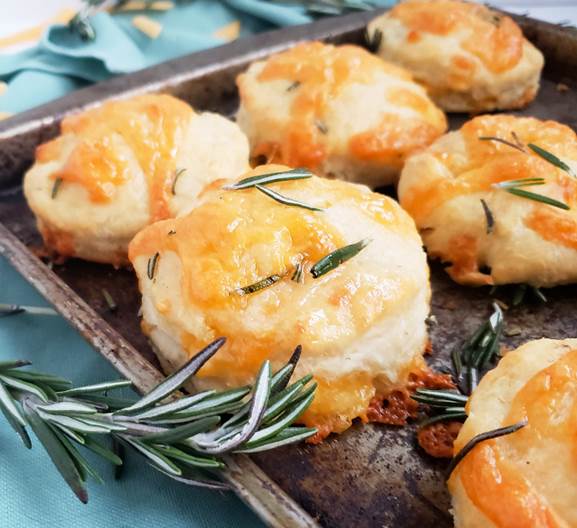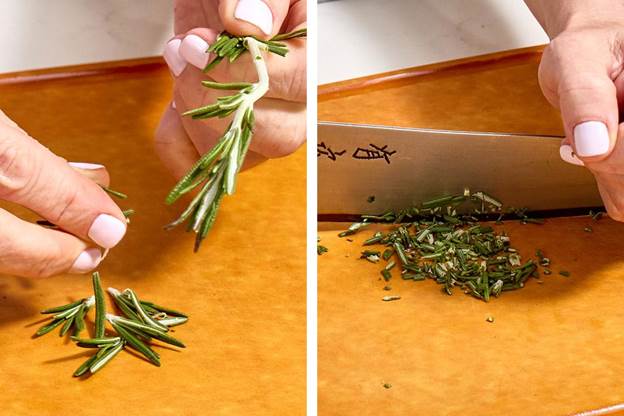Rosemary Does Much More Than Just Taste Good!
Cooking with fresh herbs is one way to take your cooking to a higher plane—we all know that. But did you also know that while adding herbs and spices to food is a wonderful way to elevate your sensory experience, adding them can help with health issues as well?

Herbs not only contribute to the flavor, smell and appearance of your dishes but are also chock-full of antioxidants and fiber. Using herbs to replace saturated fat, such as butter, is a great strategy to help manage high cholesterol without sacrificing flavor. More and more scientific research is showing up that suggests that this is a ultra smart dietary move.
And one culinary herb that’s seems to be especially useful in helping to lower cholesterol is rosemary. Rosemary, or Rosmarinus officianlis L., is rich in antioxidants, fits well into the Mediterranean diet (which is associated with reduced cholesterol levels). It contains certain phytochemicals and phenolic compounds, including carnosol, carnosic acid, rosmanol, 7-methyl-epirosmanol, isopropanol, rosmadial and caffeic acid.

All the science aside, rosemary just tastes good, don’t you think? And it pairs perfectly with extra-virgin olive oil, an unsaturated fat rich in monounsaturated fat that can assist in raising HDL (known as “good”) cholesterol and lowering LDL (known as “bad”) cholesterol.
Rosemary can be used in various ways, including adding it to food like roasted meats, potatoes, and bread; creating infused oils, vinegars, or salt; brewing it into tea; and using it for aromatherapy or as a natural scent for home products like potpourri and wreaths. It is also used in skin and hair care through scrubs, tonics, and rinses.

But it’s a potent, strongly flavored herb, so when using, it’s best to use it in moderation at first. Both fresh and dried leaves work well, but you may need to adjust the amount as dried herbs are the more potent.
The best technique for removing rosemary leaves is to slide leaves off the stem using your pointer finger and thumb, ensuring you only use the tender leaves and avoid the thick, dense center spine.

Once the leaves are removed, they can be easily chopped until they are a consistent size. For a superb taste treat, sprinkle these chopped leaves over potatoes, vegetables, and much more. Be bold and experiment. This healthy herb will bless you for it—it does so much more than just taste good!
I’ll close with one of the most popular rosemary recipes around: roasted chicken and potatoes. It’s a one-pan favorite that roasts bone-in chicken with red potatoes and whole sprigs of rosemary, infusing EVERYthing with flavor. Give it a try!
Sheet Pan Rosemary Chicken and Potatoes

6 chicken thighs bone-in and skin on
1 tablespoon fresh rosemary chopped
1/2 teaspoon dried oregano
1 teaspoon garlic powder
1 1/2 teaspoons salt
1/2 teaspoon black pepper
6 small red potatoes cleaned and quartered (not peeled)
3 tablespoons extra virgin olive oil
Several fresh rosemary sprigs for roasting and garnish
Directions:
Blend the herbs and seasonings: Combine the fresh chopped rosemary, dried oregano, garlic powder, salt, and pepper together in a small bowl.
Season the chicken: Place the thighs onto the prepared baking sheet and then pat them dry using a paper towel. Now, season the chicken with half of the herb mixture making sure to cover all of the skin.
Season the potatoes: Toss the potatoes with the remaining herb mixture and put them on the baking sheet all around the chicken. Evenly distribute the fresh rosemary sprigs amongst the chicken and potatoes. Add the oil: Drizzle the seasoned chicken thighs and potatoes with the olive oil doing your best to fully coat everything.
Bake the chicken: Transfer the sheet pan into the preheated oven and bake for 1 to 1 ¼ hours or until the potatoes are fork tender and the chicken is cooked through. When the thighs are done, the internal temperature of the chicken should be at least 165°F (75°C) when tested with an instant-read digital meat thermometer.
TIPS & NOTES
Use a large rimmed sheet pan. Your sheet pan must be at least 13×18 inches and have a rim that is about 1 inch deep. This is to ensure that your chicken and potatoes are able to be placed in a single layer as well as contain all the yummy chicken juices.
Rotate the pan. For more even cooking, rotate your sheet pan halfway through baking.
Broil for crispier skin. If you find that the skin on your baked chicken did not crisp up as much as you wanted, you can place the sheet pan under a broiler for just a few minutes to make crisps up the skin. But watch it very closely. You want crispy skin not black and burnt.
Temp your chicken. For your own health, it’s always a good idea to ensure that chicken is fully cooked and has reached 165°F (75°C) before serving. You can do this by using an instant-read digital cooking thermometer.
Recipe formatted with the Cook'n Recipe Software from DVO Enterprises.
 Alice Osborne
Alice Osborne
Weekly Newsletter Contributor since 2006
Email the author! alice@dvo.com
www.theecologycenter.com
www.masterclass.com
www.beautifuleatsandthings.com
www.themom100.com
www.cravinghomecooked.com
